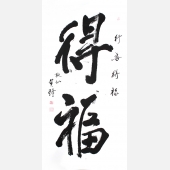Gong Jian's Artistic Language in "People's Park "
2011-04-15 11:43:42

Gong Jian’s solo exhibition: People’s Park will be on display in Boers-Li Gallery. These paintings leave behind the pastiche of high/low and folk/contemporary that characterized much of the artist’s early work, instead forging an artistic language steeped in the fragments of a half-lived life.
Gong Jian, a young artist born in 1978 and based in Wuhan, works in a diverse range of media from painting to installation. Notable for his successful willingness to work and from the periphery of the Chinese art world, he has consistently proven himself to be one of the most interesting artists of his generations by attempting to forge his own path in terms of stylistic development and social intervention.
In his earlier work, he playfully adapted the vernacular of Chinese folk painting to approach absurdist political and historical themes. Particularly well-developed is his blending of oil materials with the older graphic styles of pre-socialist realism folk painting. His brushwork reflects this variety of influences, while his use of color creates striking visual compositions that draw attention to this subtle and ironic social commentary.
Recently, he has moved towards less playful and more academically informed experiments with discourses of depth and authenticity, examining the relationship between style and content—although this is not to say that he has abandoned the crass pop culture jokes. Throughout his career, the artist has concentrated on the concept of the intervention, in both public space and art history. His newest oil paintings capture the vibrancy and visual interest of his colorful earlier works while maintaining the academic edge of his conceptually rich recent work.
Interested primarily in the possibilities of painting itself, Gong Jian has explored a vast range of both styles and subjects. None of these thematic threads ever disappear from his practice, but the artist has certainly approached specific creative directions with varying degrees of rigor and interest over the span of his early career. Here, the audience finds a reduction of the didactic and thematically postmodern; instead, they are replaced with an interrogation of the meaning of style itself.
The paintings in this exhibition revolve around the concept of the People’s Park (an urban space found in identically-named iterations in most cities across China). Representing a public space that can never be truly available to any meaningful public, such parks have become repositories for private scenes and desires: trysting students, homosexual encounters, geriatric tai-chi, revolutionary sing-alongs, and group dances are all common scenes. This space, an interface between private desires and public lives, carries a set of social and emotional connotations explored by the artist in this exhibition.
The subjects of these paintings include aggressive but empathetic takes on forests, grass, and erotic crawling figures—all pieces of Gong Jian’s cultural universe that he rips from their standard contexts and inserts into his new world of skewed visuality. These prosaic scenes are abstracted onto his canvases, transformed into static objects, and endowed with a sense of motion that comes from without. This transformation creates a space for observation via a repetitious composition that plays on light and a strong sense of contrast.
The gaze of the artist, recalling the violence of human or social presence through both visual framing and the terse brushstrokes themselves, is both harsh and melancholy. In some ways, however, this indiscernible and undifferentiated mass of the observed takes on a certain dreamlike quality, melding the oneiric and utopian infantile phantasy with the sinister and chaotic. Gong Jian’s ultimate act of artistic violence is the blurring of the subject and its background, making it difficult for the viewer to concentrate or see any clear object—the viewer, too, is subjected to the violence of this painterly gaze.
The opening reception will include a performance by Wuhan-based rock band AV Okubo, whose sets have electrified audiences across China. This show will be a not-to-miss rare visit to Beijing.

 黄琦
黄琦 测试用艺术
测试用艺术
